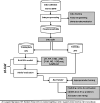Prediction of contraceptive discontinuation among reproductive-age women in Ethiopia using Ethiopian Demographic and Health Survey 2016 Dataset: A Machine Learning Approach
- PMID: 36650511
- PMCID: PMC9843668
- DOI: 10.1186/s12911-023-02102-w
Prediction of contraceptive discontinuation among reproductive-age women in Ethiopia using Ethiopian Demographic and Health Survey 2016 Dataset: A Machine Learning Approach
Abstract
Background: Globally, 38% of contraceptive users discontinue the use of a method within the first twelve months. In Ethiopia, about 35% of contraceptive users also discontinue within twelve months. Discontinuation reduces contraceptive coverage, family planning program effectiveness and contributes to undesired fertility. Hence understanding potential predictors of contraceptive discontinuation is crucial to reducing its undesired outcomes. Predicting the risk of discontinuing contraceptives is also used as an early-warning system to notify family planning programs. Thus, this study could enable to predict and determine the predictors for contraceptive discontinuation in Ethiopia.
Methodology: Secondary data analysis was done on the 2016 Ethiopian Demographic and Health Survey. Eight machine learning algorithms were employed on a total sample of 5885 women and evaluated using performance metrics to predict and identify important predictors of discontinuation through python software. Feature importance method was used to select top predictors of contraceptive discontinuation. Finally, association rule mining was applied to discover the relationship between contraceptive discontinuation and its top predictors by using R statistical software.
Result: Random forest was the best predictive model with 68% accuracy which identified the top predictors of contraceptive discontinuation. Association rule mining identified women's age, women's education level, family size, husband's desire for children, husband's education level, and women's fertility preference as predictors most frequently associated with contraceptive discontinuation.
Conclusion: Results have shown that machine learning algorithms can accurately predict the discontinuation status of contraceptives, making them potentially valuable as decision-support tools for the relevant stakeholders. Through association rule mining analysis of a large dataset, our findings also revealed previously unknown patterns and relationships between contraceptive discontinuation and numerous predictors.
Keywords: Association rule mining; Contraceptive discontinuation; Ethiopia; Ethiopian Demographic and Health Survey; Machine learning.
© 2023. The Author(s).
Conflict of interest statement
The authors declare that they have no competing interests.
Figures








Similar articles
-
Prediction of stunting and its socioeconomic determinants among adolescent girls in Ethiopia using machine learning algorithms.PLoS One. 2025 Jan 24;20(1):e0316452. doi: 10.1371/journal.pone.0316452. eCollection 2025. PLoS One. 2025. PMID: 39854425 Free PMC article.
-
Modern contraceptive utilisation and its associated factors among reproductive age women in high fertility regions of Ethiopia: a multilevel analysis of Ethiopia Demographic and Health Survey.BMJ Open. 2023 Feb 14;13(2):e066432. doi: 10.1136/bmjopen-2022-066432. BMJ Open. 2023. PMID: 36787981 Free PMC article.
-
Employing supervised machine learning algorithms for classification and prediction of anemia among youth girls in Ethiopia.Sci Rep. 2024 Apr 20;14(1):9080. doi: 10.1038/s41598-024-60027-4. Sci Rep. 2024. PMID: 38643324 Free PMC article.
-
Discontinuation of long acting reversible contraceptive use and its determinants among women in Ethiopia: Systematic review and meta-analysis.Front Public Health. 2022 Dec 6;10:979231. doi: 10.3389/fpubh.2022.979231. eCollection 2022. Front Public Health. 2022. PMID: 36561863 Free PMC article.
-
Potential biomarkers to predict return to fertility after discontinuation of female contraceptives-looking to the future.Front Reprod Health. 2023 Aug 22;5:1210083. doi: 10.3389/frph.2023.1210083. eCollection 2023. Front Reprod Health. 2023. PMID: 37674657 Free PMC article. Review.
Cited by
-
Exploring machine learning algorithms to predict not using modern family planning methods among reproductive age women in East Africa.BMC Health Serv Res. 2024 Dec 18;24(1):1595. doi: 10.1186/s12913-024-11932-x. BMC Health Serv Res. 2024. PMID: 39696425 Free PMC article.
-
Prediction of incomplete immunization among under-five children in East Africa from recent demographic and health surveys: a machine learning approach.Sci Rep. 2024 May 21;14(1):11529. doi: 10.1038/s41598-024-62641-8. Sci Rep. 2024. PMID: 38773175 Free PMC article.
-
Prediction of delayed breastfeeding initiation among mothers having children less than 2 months of age in East Africa: application of machine learning algorithms.Front Public Health. 2024 Sep 2;12:1413090. doi: 10.3389/fpubh.2024.1413090. eCollection 2024. Front Public Health. 2024. PMID: 39286748 Free PMC article.
-
Spatial variations and predictors of overweight/obesity among under-five children in Ethiopia: A geographically weighted regression analysis of the 2019 Ethiopian Mini Demographic and Health Survey.PLoS One. 2024 Oct 14;19(10):e0312025. doi: 10.1371/journal.pone.0312025. eCollection 2024. PLoS One. 2024. PMID: 39401190 Free PMC article.
-
Explainable machine learning algorithms to identify predictors of intention to use family planning among women of reproductive-age in Ethiopia: Evidence from the Performance Monitoring and Accountability (PMA) 2021 survey data set.BMJ Public Health. 2025 Apr 17;3(1):e000962. doi: 10.1136/bmjph-2024-000962. eCollection 2025. BMJ Public Health. 2025. PMID: 40557287 Free PMC article.
References
-
- Aljanabi M, Qutqut H, Hijjawi M. Machine learning classification techniques for heart disease prediction: a review. Int J Eng Technol. 2018;7(4):5373–5379.
-
- Ali MM, Cleland JG, Shah IH, World Health O. Causes and consequences of contraceptive discontinuation: evidence from 60 demographic and health surveys. Geneva: World Health Organization; 2012.
MeSH terms
Substances
LinkOut - more resources
Full Text Sources

